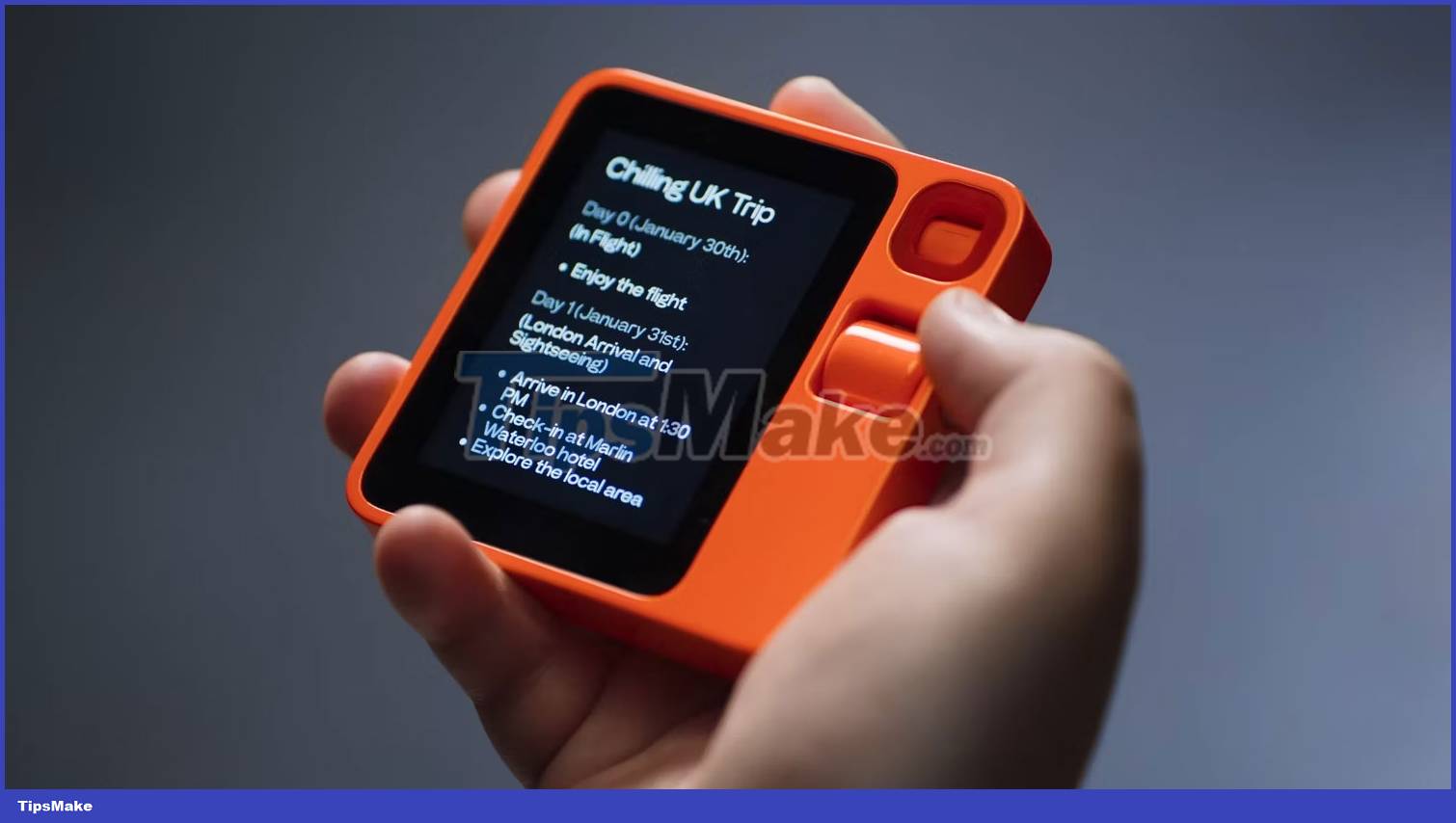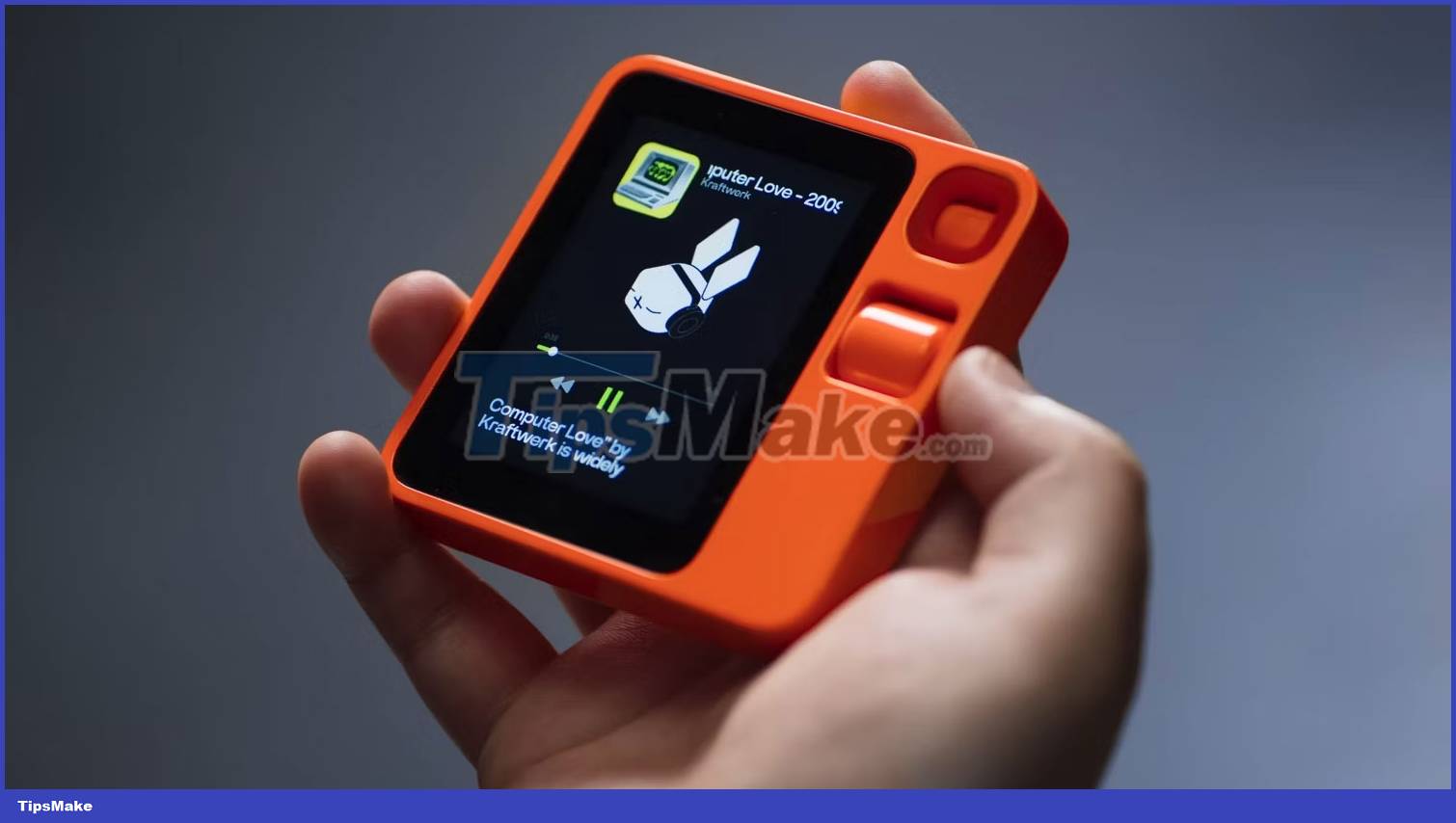Learn about Rabbit R1: AI phone without apps
CES is a showcase for some of the most powerful technology today, but one product that attracted attention above all else this year was the Rabbit R1. Technically, it's a smartphone, but it's unlike any other smartphone you've ever used. It is at the forefront of innovation, applying AI at a level that no smartphone manufacturer has thought of today.
The Rabbit R1 doesn't have apps like a phone in your pocket, but relies on an AI-based synthetic voice bot to get the job done for you - and people are keen to know more about this new approach to phones. smart phone. But how exactly does this orange phone work and is its basic idea practical?
What is Rabbit R1?
You need to rely on dozens of apps to get work done on your current smartphone, and that's become the norm since the advent of smartphones and app stores. That means there's a corresponding app for every need you have, like shopping, ordering food, and taking notes, among others. Rabbit wants to reimagine that with the help of AI, where your phone does it all on your behalf with just one natural language command. And there are two parts to how Rabbit tries to put the whole experience together.
Large Action Model (LAM)
While you may have heard of large language models (LLMs) that help generative AI learn and provide information for you (as opposed to performing a task for you), Large Action Models ( LAM) - large action model - by Rabbit aims to make AI more useful. From the company's demo video, it appears that the company has trained its LAM to understand how a person uses the app for different purposes - such as adding songs to a Spotify playlist. Its biggest strength, the company says, is its ability to perform more complex tasks, such as connecting to multiple services to plan your travel itinerary. (Rabbit doesn't specify whether it is training LAM manually or using some type of automation).
There's also a demo tutorial mode that lets you give LAM a quick demo of how to perform a task in traditional software. Rabbit will upload the screen recording to its cloud for further processing, then, in theory, it will be able to replicate the task the same way you taught it. All of these smart features ultimately power Rabbit OS - the unique, minimal operating system at the heart of the Rabbit R1.
New appearance

The Rabbit R1 doesn't look like a regular smartphone - and the bright orange color isn't the only factor. This square device has a fairly small screen, a 360-degree rotating camera, a physical scroll wheel, two long-range microphones and a push-to-talk button on the side - that's it. Everything you do on your phone happens through a combination of these tools.
To use the R1, you need to press the side button and give a voice command, it will complete the task on apps connected to the operating system (it supports a range of popular apps including YouTube Music, Amazon, Doordash and Uber). You can ask it to play a song on Spotify or even order food after confirming payment. As said before, for complex tasks, for example, the Rabbit R1 can book your plane tickets on one app and hotels on the second app with just one command. And all this will happen without you having to lift a finger.
Rabbit emphasizes that the phone respects your privacy as it only starts listening when you press the side button, while the rotating camera is also blocked when not in use. The company claims that response times are fairly minimal, even though processing takes place in the cloud and the phone has long-term memory to fine-tune future responses based on your preferences.

The operating system running everything is Rabbit OS, which itself is quite minimalist with a mostly dark background and a text-heavy interface. Since there's no app to view, there's not much to interact with on the phone - at least that's what one can gather from the introductory video. In addition to text, you can also do visual searches using the camera to show you what you see. Rabbit R1 currently supports English, but there are plans to add more international languages such as French, German, Hindi, Japanese and Spanish and make the chatbot bilingual.
Since all the processing happens in the cloud, the phone doesn't need much horsepower. The Rabbit R1 comes with a modest MediaTek P35 processor along with 4GB of RAM and 128GB of storage. The device supports 4G, has a basic 2.88-inch touch screen, 1000mAh battery and 8MP camera.
For a novel device that the company wants to see widespread adoption, the Rabbit R1 costs just $200, making it relatively affordable compared to smartphones. That's why so many people have pre-ordered one from the official website. First deliveries are expected to begin at the end of March 2024.

Go into detail
There are many things that have not been said on stage
In Rabbit's opening keynote, the company showed how it solves the problems of both voice assistants not working and phones crammed with too many apps. However, towards the end, Rabbit went against its own vision and announced that it has no plans to replace your current phone. Ambiguity in messaging can be a problem for long-term business positioning, and there are a number of things that concern end users these days.
While it all sounds optimistic on the surface, digging a little deeper raises some serious questions. The company has put quite a bit of emphasis on user privacy, but there's little clarity on how exactly your services like Apple Music are connected to Rabbit OS. Does Rabbit's server have full access to your connected applications? (To be clear, Rabbit does not have access to your passwords because logging into these services takes place on their respective login pages)

Furthermore, when everything happens in the cloud, how will offline experiences work, such as saving playlists when you're on the go? Plus, the visual interface looks very text-heavy. Some things are done better with visual feedback, like quickly looking at an image of the meal you're looking forward to instead of hearing a voice bot read text that takes a few seconds.
Voice prioritization also means that people with speech impediments cannot use the phone effectively. The Rabbit R1 scores poorly on accessibility, at least for now - although it could one day benefit the visually impaired. However, without an interactive touch interface, phones are a problem for people in situations where you can't speak or hear the phone's response, or in situations where talking to a device is difficult. would be rude.

You should read it
- Top 5 best photography apps on iPhone and Android phones
- 8 best AI apps to download on your phone
- 9 malicious applications on Google Play, if installed, should be removed immediately
- Top 5 best free VPN apps for phones today
- How to lock apps on Android phones
- 8 free wallpaper changes apps on Android and download links
- How to Uninstall Updates on Android
- These framed art apps for phones
May be interested
- Invite to admire the iPhone 2019 concept, high forehead, no rabbit ears, spill bottom like Bphone 3
 youtube phone industry channel owner, one of those who do not like to design iphone rabbit ear screen has created an extremely unique iphone 2019 concept with screen without rabbit ears, bottom overflow, high forehead to put speakers, front camera and sensor.
youtube phone industry channel owner, one of those who do not like to design iphone rabbit ear screen has created an extremely unique iphone 2019 concept with screen without rabbit ears, bottom overflow, high forehead to put speakers, front camera and sensor. - Bad Rabbit - Petya's new ransomware spreads throughout Eastern Europe
 a new ransomware called bad rabbit is stirring up many countries in eastern europe, including government and business units. the spread rate is similar to wannacry and notpetya which took place in may and june.
a new ransomware called bad rabbit is stirring up many countries in eastern europe, including government and business units. the spread rate is similar to wannacry and notpetya which took place in may and june. - Why doesn't the iPhone drop the notch?
 from the old models to the new x models, the iphone has got an iconic look. you instantly recognize it thanks to the exact aspect ratio, rounded corner radius, as well as the combination of the screen and the home button.
from the old models to the new x models, the iphone has got an iconic look. you instantly recognize it thanks to the exact aspect ratio, rounded corner radius, as well as the combination of the screen and the home button. - LG unveiled the G7 phone at Mobile World Congress, with rabbit ears similar to iPhone X
 is this true that lg g7 is not?
is this true that lg g7 is not? - Discovered new ransomware called White Rabbit, related to the notorious FIN8 hacker group
 a new family of ransomware called white rabbit has just been discovered by researchers. according to research results, it is possible that this ransomware is a side activity of the notorious fin8 hacker group.
a new family of ransomware called white rabbit has just been discovered by researchers. according to research results, it is possible that this ransomware is a side activity of the notorious fin8 hacker group. - Latest Rabbit Village Secret Bunkage Code and how to redeem code
 bunkage secret art of rabbit village offers you many attractive rewards and currencies via giftcode
bunkage secret art of rabbit village offers you many attractive rewards and currencies via giftcode - Four ways to delete unwanted apps from your Android phone
 clear out the junk and clutter of random apps on your android phone or tablet with just a couple of taps.
clear out the junk and clutter of random apps on your android phone or tablet with just a couple of taps. - 11 amazing Android apps that will change the way you use your phone
 there are apps that will completely change the way you use your android device. some improve the user interface, automate common tasks, and some take common features in the operating system and improve them to be better.
there are apps that will completely change the way you use your android device. some improve the user interface, automate common tasks, and some take common features in the operating system and improve them to be better. - Why many Android phones imitate rabbit ears of iPhone X?
 which is the most hated thing on iphone x, why are more and more android phones imitating this design feature of apple?
which is the most hated thing on iphone x, why are more and more android phones imitating this design feature of apple? - 3 best Android apps to know who unlocked your phone
 the 3 android apps below let you use your device's front camera to take a photo of someone when they try to unlock your phone.
the 3 android apps below let you use your device's front camera to take a photo of someone when they try to unlock your phone.










 What should iFan do when iPhone cannot transfer data?
What should iFan do when iPhone cannot transfer data? How to use Copilot in OneNote
How to use Copilot in OneNote Should you stream or download your favorite content?
Should you stream or download your favorite content? Why does your Apple Watch stop charging at 80%?
Why does your Apple Watch stop charging at 80%? What is AI Prompt Injection attack?
What is AI Prompt Injection attack? Instructions for canceling Copilot Pro subscription
Instructions for canceling Copilot Pro subscription